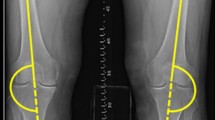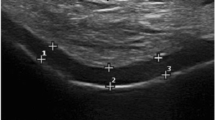Abstract
Objectives
To investigate any differences in muscle architecture (fascicle angle, fascicle length, and muscle thickness) and muscle strength in people of different ages with and without knee osteoarthritis (OA).
Methods
This is a cross-sectional study conducted with 40 individuals with and 40 without knee OA. Four groups were analyzed, middle-aged OA group (KL II/III) aged 40–50 years (n = 20), middle-aged healthy (H) group aged 40–50 years (n = 20), older OA group (KL II/III) aged 70 years and over (n = 20), and older H group, aged 70 years and over (n = 20). Outcomes analyzed were isometric and isokinetic peak torque of knee extensors, level of physical activity, self-reported pain level, and vastus lateralis fascicle length, fascicle angle, and muscle thickness assessed by ultrasound. One-way ANOVA was used to identify differences between groups, followed by the Tukey post hoc test.
Results
There were no differences between the middle-aged OA group and older H group for any variables. The older OA group presented the smallest muscle architecture parameters and worst isometric and concentric peak torques compared to the other three groups (p < 0.001). In contrast, the middle-aged H group presented the largest muscle architecture parameters and was the strongest group compared to the others (p < 0.001).
Conclusions
The presence of knee OA is associated with early muscular changes and seems to intensify these thigh changes that are similar to the effects of the aging process.

Similar content being viewed by others
References
Arden NK, Leyland KM (2013) Osteoarthritis year 2013 in review: clinical. Osteoarthr Cartil 21:1409–1413. https://doi.org/10.1016/j.joca.2013.06.021
Litwic A, Edwards MH, Dennison EM, Cooper C (2013) Epidemiology and burden of osteoarthritis. Br Med Bull 105:185–199. https://doi.org/10.1093/bmb/lds038
Zhang Y, Jordan JM (2010) Epidemiology of osteoarthritis. Clin Geriatr Med 26:355–369. https://doi.org/10.1016/j.cger.2010.03.001
Loeser RF (2010) Age-related changes in the musculoskeletal system and the development of osteoarthritis. Clin Geriatr Med 26:371–386. https://doi.org/10.1016/j.cger.2010.03.002
Roos EM, Herzog W, Block JA, Bennell KL (2011) Muscle weakness, afferent sensory dysfunction and exercise in knee osteoarthritis. Nat Rev Rheumatol 7:57–63. https://doi.org/10.1038/nrrheum.2010.195
Ma VY, Chan L, Carruthers KJ (2014) Incidence, prevalence, costs, and impact on disability of common conditions requiring rehabilitation in the United States: stroke, spinal cord injury, traumatic brain injury, multiple sclerosis, osteoarthritis, rheumatoid arthritis, limb loss, and back pa. Arch Phys Med Rehabil 95:986–995.e1. https://doi.org/10.1016/j.apmr.2013.10.032
Palmieri-Smith RM, Thomas AC, Karvonen-Gutierrez C, Sowers MF (2010) Isometric quadriceps strength in women with mild, moderate, and severe knee osteoarthritis. Am J Phys Med Rehabil 89:541–548. https://doi.org/10.1097/PHM.0b013e3181ddd5c3
Alnahdi AH, Zeni JA, Snyder-Mackler L (2012) Muscle impairments in patients with knee osteoarthritis. Sports Health 4:284–292. https://doi.org/10.1177/1941738112445726
Petterson SC, Barrance P, Buchanan T et al (2008) Mechanisms underlying quadriceps weakness in knee osteoarthritis. Med Sci Sports Exerc 40:422–427. https://doi.org/10.1249/MSS.0b013e31815ef285
Vaz MA, Baroni BM, Geremia JM, Lanferdini FJ, Mayer A, Arampatzis A, Herzog W (2013) Neuromuscular electrical stimulation (NMES) reduces structural and functional losses of quadriceps muscle and improves health status in patients with knee osteoarthritis. J Orthop Res 31:511–516. https://doi.org/10.1002/jor.22264
Trezise J, Collier N, Blazevich AJ (2016) Anatomical and neuromuscular variables strongly predict maximum knee extension torque in healthy men. Eur J Appl Physiol 116:1159–1177. https://doi.org/10.1007/s00421-016-3352-8
Ticinesi A, Meschi T, Narici MV, Lauretani F, Maggio M (2017) Muscle ultrasound and sarcopenia in older individuals: a clinical perspective. J Am Med Dir Assoc 18:290–300. https://doi.org/10.1016/j.jamda.2016.11.013
Abe T, Kawakami Y, Suzuki Y et al (1997) Effects of 20 days bed rest on muscle morphology. J Gravit Physiol a J Int Soc Gravitational Physiol 4:S10–S14
Selva Raj I, Bird SR, Shield AJ (2017) Ultrasound measurements of skeletal muscle architecture are associated with strength and functional capacity in older adults. Ultrasound Med Biol 43:586–594. https://doi.org/10.1016/j.ultrasmedbio.2016.11.013
Strasser EM, Draskovits T, Praschak M, Quittan M, Graf A (2013) Association between ultrasound measurements of muscle thickness, pennation angle, echogenicity and skeletal muscle strength in the elderly. Age (Omaha) 35:2377–2388. https://doi.org/10.1007/s11357-013-9517-z
Malas FÜ, Özçakar L, Kaymak B, Ulaşlı A, Güner S, Kara M, Akıncı A (2013) Effects of different strength training on muscle architecture: clinical and ultrasonographic evaluation in knee osteoarthritis. PM R 5:655–662. https://doi.org/10.1016/j.pmrj.2013.03.005
Lieber RL (2011) Skeletal muscle structure, function, and plasticity
Blazevich AJ, Cannavan D, Coleman DR, Horne S (2007) Influence of concentric and eccentric resistance training on architectural adaptation in human quadriceps muscles. J Appl Physiol 103:1565–1575. https://doi.org/10.1152/japplphysiol.00578.2007
Altubasi IM (2015) Is quadriceps muscle strength a determinant of the physical function of the elderly? J Phys Ther Sci 27:3035–3038. https://doi.org/10.1589/jpts.27.3035
Liikavainio T, Isolehto J, Helminen HJ, Perttunen J, Lepola V, Kiviranta I, Arokoski JPA, Komi PV (2007) Loading and gait symmetry during level and stair walking in asymptomatic subjects with knee osteoarthritis: importance of quadriceps femoris in reducing impact force during heel strike? Knee 14:231–238. https://doi.org/10.1016/j.knee.2007.03.001
Mothersill C, Seymour CB, O’Brien A (1991) Induction of c-myc oncoprotein and of cellular proliferation by radiation in normal human urothelial cultures. Anticancer Res 11:1609–1612. https://doi.org/10.1002/jor
Gonçalves GH, Selistre LFA, Petrella M, Mattiello SM (2017) Kinematic alterations of the lower limbs and pelvis during an ascending stairs task are associated with the degree of knee osteoarthritis severity. Knee 24:295–304. https://doi.org/10.1016/j.knee.2017.01.007
Kellgren JH, Lawrence JS (1957) Radiological assessment of osteo-arthrosis. Ann Rheum Dis 16:494–502. https://doi.org/10.1136/ard.16.4.494
Heuts PHTG, Vlaeyen JWS, Roelofs J, de Bie RA, Aretz K, van Weel C, van Schayck OCP (2004) Pain-related fear and daily functioning in patients with osteoarthritis. Pain 110:228–235. https://doi.org/10.1016/j.pain.2004.03.035
Bennell KL, Hinman RS, Metcalf BR, Crossley KM, Buchbinder R, Smith M, McColl G (2003) Relationship of knee joint proprioception to pain and disability in individuals with knee osteoarthritis. J Orthop Res 21:792–797. https://doi.org/10.1016/S0736-0266(03)00054-8
Davison MJ, Ioannidis G, Maly MR, Adachi JD, Beattie KA (2014) Intermittent and constant pain and physical function or performance in men and women with knee osteoarthritis: data from the osteoarthritis initiative. Clin Rheumatol. https://doi.org/10.1007/s10067-014-2810-0
Altman R, Asch E, Bloch D, Bole G, Borenstein D, Brandt K, Christy W, Cooke TD, Greenwald R, Hochberg M, Howell D, Kaplan D, Koopman W, Longley S, Mankin H, McShane DJ, Medsger T, Meenan R, Mikkelsen W, Moskowitz R, Murphy W, Rothschild B, Segal M, Sokoloff L, Wolfe F (1986) Development of criteria for the classification and reporting of osteoarthritis: classification of osteoarthritis of the knee. Arthritis Rheum 29:1039–1049. https://doi.org/10.1002/art.1780290816
de Almeida AC, Pedroso MG, Aily JB, Gonçalves GH, Pastre CM, Mattiello SM (2018) Influence of a periodized circuit training protocol on intermuscular adipose tissue of patients with knee osteoarthritis: protocol for a randomized controlled trial. BMC Musculoskelet Disord 19:421. https://doi.org/10.1186/s12891-018-2325-y
Berg HE, Tedner B, Tesch PA (1993) Changes in lower limb muscle cross-sectional area and tissue fluid volume after transition from standing to supine. Acta Physiol Scand 148:379–385. https://doi.org/10.1111/j.1748-1716.1993.tb09573.x
Karamanidis K, Arampatzis A (2006) Mechanical and morphological properties of human quadriceps femoris and triceps surae muscle-tendon unit in relation to aging and running. J Biomech 39:406–417. https://doi.org/10.1016/j.jbiomech.2004.12.017
Serrão PRMS, Vasilceac FA, Gramani-Say K, Lessi GC, Oliveira AB, Reiff RBM, Mattiello-Sverzut AC, Mattiello SM (2015) Men with early degrees of knee osteoarthritis present functional and morphological impairments of the quadriceps femoris muscle. Am J Phys Med Rehabil 94:70–81. https://doi.org/10.1097/PHM.0000000000000143
Taniguchi M, Fukumoto Y, Kobayashi M, Kawasaki T, Maegawa S, Ibuki S, Ichihashi N (2015) Quantity and quality of the lower extremity muscles in women with knee osteoarthritis. Ultrasound Med Biol 41:2567–2574. https://doi.org/10.1016/j.ultrasmedbio.2015.05.014
Bijur P, Silver W, Gallagher E (2001) Reliability of the visual analog scale for measurement of acute pain. Acad Emerg Med 8:1153–1157. https://doi.org/10.1111/j.1553-2712.2001.tb01132.x
Bellamy N, Buchanan WW, Goldsmith CH, Campbell J, Stitt LW (1988) Validation study of WOMAC: a health status instrument for measuring clinically important patient relevant outcomes to antirheumatic drug therapy in patients with osteoarthritis of the hip or knee. J Rheumatol 15:1833–1840
Gamst G, Meyers LS, Guarino AJ (2008) Analysis of variance designs: a conceptual and computational approach with SPSS and SAS, 1st edn. Cambridge University Press, New York, NY, USA
Ikeda S, Tsumura H, Torisu T (2005) Age-related quadriceps-dominant muscle atrophy and incident radiographic knee osteoarthritis. J Orthop Sci 10:121–126. https://doi.org/10.1007/s00776-004-0876-2
Geremias JM, Baroni BM, Lanferdini FJ et al (2018) Time course of neuromechanical and morphological adaptations to triceps surae isokinetic eccentric training. Phys Ther Sport 34:84–91. https://doi.org/10.1016/j.ptsp.2018.09.003
Morse CI, Thom JM, Birch KM, Narici MV (2005) Changes in triceps surae muscle architecture with sarcopenia. Acta Physiol Scand 183:291–298. https://doi.org/10.1111/j.1365-201X.2004.01404.x
Narici MV, Maganaris CN, Reeves ND, Capodaglio P (2003) Effect of aging on human muscle architecture. J Appl Physiol 95:2229–2234. https://doi.org/10.1152/japplphysiol.00433.2003
Cunningham DA, Morrison D, Rice CL, Cooke C (1987) Ageing and isokinetic plantar flexion. Eur J Appl Physiol Occup Physiol 56:24–29. https://doi.org/10.1007/BF00696371
Hortobagyi T, Zheng D, Weidner M et al (1995) The influence of aging on muscle strength and muscle fiber characteristics with special reference to eccentric strength. J Gerontol A Biol Sci Med Sci 50:B399–B406
Roelofs J, Van Breukelen G, Sluiter J et al (2011) Norming of the Tampa Scale for Kinesiophobia across pain diagnoses and various countries. Pain 152:1090–1095. https://doi.org/10.1016/j.pain.2011.01.028
Vandervoort AA, Hayes KC (1989) Plantarflexor muscle function in young and elderly women. Eur J Appl Physiol Occup Physiol 58:389–394. https://doi.org/10.1007/BF00643514
Riddle DL, Stratford PW (2011) Impact of pain reported during isometric quadriceps muscle strength testing in people with knee pain: data from the osteoarthritis initiative. Phys Ther 91:1478–1489. https://doi.org/10.2522/ptj.20110034
Acknowledgments
The authors would like to thank the National Council for Scientific and Technological Development (CNPq) and São Paulo Research Foundation (FAPESP) for the financial support to the investigators of this study and Hugo Alexandre Puretachi, radiologist technician at University Hospital of the Federal University of São Carlos, for performing the radiography exams.
Author information
Authors and Affiliations
Corresponding author
Ethics declarations
Disclosures
None.
Additional information
Publisher’s note
Springer Nature remains neutral with regard to jurisdictional claims in published maps and institutional affiliations.
Rights and permissions
About this article
Cite this article
Aily, J.B., de Noronha, M., de Almeida, A.C. et al. Evaluation of vastus lateralis architecture and strength of knee extensors in middle-aged and older individuals with knee osteoarthritis. Clin Rheumatol 38, 2603–2611 (2019). https://doi.org/10.1007/s10067-019-04539-9
Received:
Revised:
Accepted:
Published:
Issue Date:
DOI: https://doi.org/10.1007/s10067-019-04539-9




